Franz Kröger (editor) [endn.1]
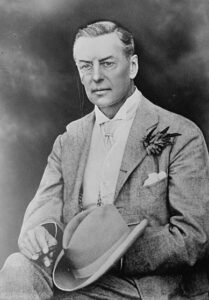
Joseph Chamberlain
(Extract):
Public Record Office. London
Co 879. 78. 05939
No. 25352
No. 5
Governor MAJOR NATHAN [endn. 2] to Mr. CHAMBERLAIN [endn. 3]
(Received June. 1902)
(Confidential)
Despatch relating to Field Operations
Government House, Accra, May 31, 1902.
Sir,
I have the honour to transmit the report of Lieutenant-Colonel A.H. Morris, D.S.O. [endn. 4] on the recent expedition into the Tiansi [endn. 5] country of the Northern Territories.
2. From his report it appears that in the eighteen days between the 11th and 27th March, during which the main column of the expeditionary force was absent from Gambaga [endn. 6] , some 250 miles or country were traversed, an that four days’ fighting took place, in which the hostile tribes lost about a hundred killed, while the total losses of the expeditionary forces were five irregular horse killed and one carrier died. Various palavers were held with the friendly chiefs, the submission of the hostile ones was subsequently made and accepted, and much useful information with regard to the topography of the country and its chiefs and tribes was collected.
3. The details of the expedition are perfectly clear from Lieutenant-Colonel Morris’s concise report, and the diary which accompanies it, and are illustrated by the excellent map prepared by Captain O’Kinealy, R.A.
4. Lieutenant-Colonel Morris acted judiciously in confining his operations to what was necessary to secure the main purpose of the expedition, viz.: the punishment of those tribes who have made a practice of raiding an ill-treating their more loyal and peaceful neighbours….
M. Nathan, Governor
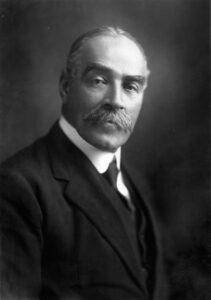
M. Nathan
Enclosure in No.5
(No. 0/105/N.T./02.)
Gambaga, April 26, 1903.
Sir,
I have the honour to forward a report on the late expedition into the Tiansi country.
2. Attached are a diary of the progress of the expedition, a sketch of the route traversed [endn.7] a return of ammunition expended, and a medical report on the health of the troops.
3. At the end of February the French Resident in Moshi, with whom I had been in communication regarding a joint expedition along the frontier, finally wrote to inform me that he had received instructions from His Government that he was not to go south of the 11th parallel.
I was therefore unable to visit several towns which, though lying to the south of the 11th parallel, have been declared “neutral” till the recommendations of the Anglo-French boundary Commission have been ratified.
4. As Your Excellency is aware, the objects of the expedition were first to punish the turbulent town of Nafrongo, which for some considerable time past has been levying blackmail on the neighbouring towns, and then to visit the country lying close to the 11th parallel or north latitude, between 0° 30′ and 1° 0′ west longitude.
On my arrival at Paha [Paga] I learnt that the kingdom of Sinlieh [Sandema], lying about six miles to the south of Tiana, was most hostile, and a scourge to the whole neighbourhood: I therefore determined to visit this country. The defeat of the people of Nafrongo and Sinlieh, the severe punishment inflicted on them, and the progress of the expedition have been fully detailed in the diary of events.
5. The three kingdoms of Nafrongo, Tiana, and Sinlieh [endn. 8] are by far the most important of any that I have seen in these territories they each extend over about twenty square miles of country, with compounds every two or three hundred yards, and are densely populated. The chief occupation of the inhabitants is farming, many acres of ground being put under cultivation.
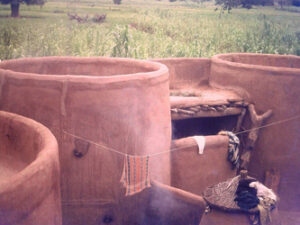
Flat-roofed houses with the connecting outer wall
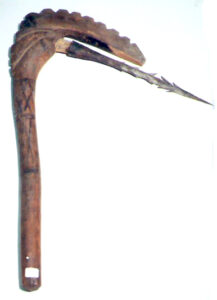
The battle axe (kpaani)
War-helmet with antelope horns (Photo via John Agandin)
6. I was much struck with the excellent way in which the compounds in Sinlieh are built; they are circular in shape, and are made of very thick swish [endn.9] , smoothed and polished.
They have high walls, which form the outer parts of each hut in the compound, connecting them together. The roofs are flat with a small parapet three feet high all round, so that the owner of the compound with his followers can successfully defend himself against his neighbours, armed only with the same primitive weapons as himself. I found these walls were not, however, proof against rifle fire [endn.10].
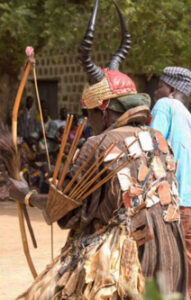
War-helmet with antelope horns Photo via John Agandin
7. The full fighting dress worn by the people of Sinlieh is both imposing and picturesque. It consists of a headdress made of thickly plaited straw, in shape much resembling the steel cap worn by the old Crusaders; this is covered with hide, and into it are fixed the horns of a Hartebeest or some other large antelope. Their bodies are protected by an enormous arrow-proof shield of oxhide, which covers them from head to foot. Their weapons are bows and poisoned arrows, also a kind of “battle axe”, with a short wooden handle, and an iron pick-shaped head, about inches long, running to a point, with barbs on either side along half of its length. These axes are poisoned, being used to inflict the “coup de grâce” to their enemies.
8. Since I began writing this report the Kings of Nafrongo and Sinlieh, with a representative from each of their chiefs [endn. 11], have arrived in Gambaga to make submission, and to ask that they may be given the English flag [endn. 12]. They faithfully promise that they will in future abstain from molesting their neighbours, and will obey all orders given them. I have accepted their presents, giving them liberal ones in return, and informed them that no further punishment will be inflicted on them, provided they faithfully carry out my orders. I have also given them the English flag. It is with the greatest satisfaction that I am able to report the submission of these Kings, as I alm confident that there will now be more blackmailing of caravans or molesting of their less warlike neighbours.
The prestige hitherto enjoyed by theses people is broken, and in a very few months I have every hope of enlisting excellent recruits from the people of Sinlieh, who are Kanjargas, one the most warlike tribes in this Hinterland [endn. 13].
9. In Mamprusi and Dagomba each town consists of a collection of huts close together under a King whose authority is absolute, but in Tiansi, Grunshi, and Fra Fra the conditions are so different that I consider it most desirable they should be especially brought to notice in connection with this expedition. From Na up to Paha in the north, Sinlieh in the west, and Zebilla in the east, the so-called towns are in reality districts, consisting of a collection of compounds (containing from ten to twenty huts) [endn. 14] scattered about at intervals of two or three hundred yards over a very wide extent of country. The King’s compound is a larger one [endn. 15] than the others, but in many cases his power is little more than nominal.
There being no central form of government greatly increases the difficulty of properly administering these districts [endn. 16]. I endeavoured, therefore, in inflicting punishment on the towns of Nafrongo and Sinlieh, to see, that all the chiefs were equally punished by having their compounds destroyed and their foodstuffs carried off.
This punishment has had the desired effect, as representatives from all the chiefs have come in to make submission…
A. Morris, Lieutenant-Colonel,
Chief -Commissioner, Northern Territories
His Excellency
The Governor, Accra
DIARY OF EXPEDITION TO THE TIANSI COUNTRY
March 11
The Field Force left Gambaga at 8 a.m., composed as follows:
Lieutenant-Colonel A. Morris, D.S.O., West African Frontier Force, in command.
Staff Officer Captain H. Walker-Leigh, West African Frontier Force
Captain J. O’Kinealy,
Captain and Adjutant J. Marlow,
Lieutenant J. Mc. C. Griffin,
Lieutenant W – Van Eeden, West African Frontier Force.
Medical Officers:
Assistant Colonial Surgeon P.M Tobit, Principal Medical Officer
Assistant Colonial Surgeon J.C. Bhuttacharji,
Doctor H.T. Bury (Special Service)
Doctor D. Cogan (Special Service)
Native Officer:
Native Officer Osumanu
5 Native Subordinates.
Battery:
28 Non-commissioned officers and men
Infantry:
242 Non-commissioned officers and men (this includes 15 mounted infantry)
43 Moshi horsemen
One 7-pounder gun [endn. 17], one Maxim [endn. 18], and one rocket trough, accompanied the force…
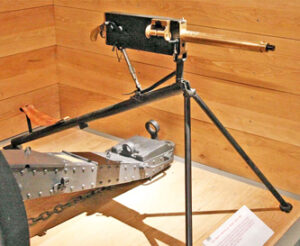
Tripod-mounted Maxim machine gun Source: Wikipedia
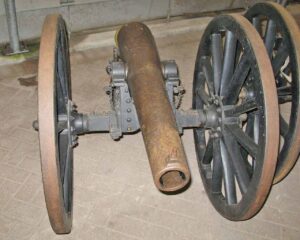
A 7 pounder gun Source: Wikimedia
March 19
Lieutenant Roy was sent out to Nafrongo with a company of infantry and all the carriers to bring in all the corn he could find, and to destroy as many compounds as possible.
I held a large palaver in the afternoon and received the Kings of Paha, Chulchulga [Chuchuliga], Tiana and Meerigu [Mirigu], who were accompanied by their chiefs.
The leaders of a caravan from Wagadugu en route to Salaga also came to see me, and expressed their delight at the utter defeat of the people of Nafrongo, who had for many years past looted all caravans passing through their district [endn. 19].
I despatched a convoy of two hundred captured cattle to Gambaga by the King of Chulchulga, who engaged to safely deliver them.
I gave this King a flock of eighty sheep to compensate him for the losses he had sustained some months ago at the hands of the people of Nafrongo.
March 20
Left Paha at 6 a.m. and marched with the mounted troops till 7.15 a.m., when we reached a dried-up stream [endn. 20] (5 miles).
The road to Tiana lay through considerably ticker country than usual; a very large stream [endn. 21] (dry) with steep bank was crossed about 8.30 a.m. (8 miles).
We reached the borders of Tiana at 10 a.m., and the camping ground, near some water holes, at 11 a.m. (17 miles).
The King of Tiana had come in to see me at Paha, and accompanied us from that place to his own country. His people were very friendly, bringing large quantities of water for the troops.
In the evening I held a large reception of all the chiefs of Tiana; they informed me that the people of Sinlieh were most hostile, and owing to their having defeated Barbatu on two occasions [endn. 22] had a vast idea of their own power and importance.
March 21
I left camp this morning at daybreak with a flying column composed of all the mounted troops, one 7- pounder gun, one Maxim and 120 infantry.
At 7.45 a.m. the outskirts of Sinlieh were reached (6 miles), and the compounds were found abandoned [endn. 23].
At 8.45 a.m., after we had got well into the Sinlieh country, small bodies of armed men were seen in all directions, gradually massing together. A large body had taken up a position on some small rocks.
I brought the 7-pounder gun and Maxim into action, forming the infantry into three lines; being driven out of the rocks the enemy took up a further position a few hundred yards in rear, which they held on to for a short time, but the fire of the Maxim and the steady volleys of the firing line drove them out, after which they broke up into twos and threes and fled in all directions.
The Moshi horsemen were then ordered up in pursuit, which they carried out in the most thorough manner.
I went on to the King’s house, which we destroyed. We returned to the camp at Tiana in the afternoon. The enemy had thirty men killed during the day’s fighting. Our casualties being four Moshi horsemen wounded and three horses wounded.
It is impossible to estimate the number of the enemy wounded, as they are always taken off by their friends.
March 22
I again went out to Sinlieh from Tiana with the same force as yesterday, and a large number of carriers, with the intention of bringing in all the foodstuffs I could find, and destroying as many compounds as possible.
No signs of the enemy were seen, the whole district, about twenty square mile, being abandoned. The column returned to Tiana in the evening.
March 23
Halted at Tiana. Chiefs from various towns round came in to see me, bringing presents and cattle, and asking for the English flag; the chiefs of these were the Kings of Kayoro, Bawarti, and Kasimar [endn. 24].
March 24
Left Tiana at 5.55 a.m to-day, arriving at some water holes at 7.10 a.m. (5 miles). Met the King of Chulchulga a mile further on, who came to escort us through his country to Dober [Doba]. We passed the King of Chulchulga’s compound at 8 a.m. (7 miles), and reached a very fine stream [endn. 25] at 9 a.m. (11 miles). We watered the horses there and halted for half an hour. At 9.45 a.m. (12 miles) we passed through the southernmost outskirts of Nafrongo. We reached Dober at 10.40 a.m. (16 miles); the place was practically speaking deserted except by half a dozen people, who came out with white fowls; they brought water, etc.
A carrier died to-day of apoplexy [endn. 26] and exhaustion; the heat was intense and the men felt it very considerably.
The King of Dober came in this evening and said that he had fled into the bush because he was afraid the he might be accused of harbouring Nafrongo people, some of whom had fled to his town…
A. Morris Lieutenant-Colonel
Chief Commissioner,
Northern Territories
Gambaga,
April 25, 1902
ENDNOTES
1 Even before my first visit to the National Archives (Public Record Office) of the United Kingdom in Kew the text of this report was made available to me by the late Dr. Edward Norris (Münster) and Jay Moon (then in Kanjaga). Photos, footnotes and interpolations [in square brackets] were inserted by the editor.
2 Lieutenant Colonel Sir Matthew Nathan (1862-1939) was a colonial administrator, who variously served as the Governor of Sierra Leone, Gold Coast (1900-1904), Hong Kong, Natal and Queensland (Wikipedia).
3 Joseph Chamberlain (1836-1914), became Colonial Secretary of the British Government in June 1985
4 A.H. Morris, D.S.O was at that time Chief-Commissioner of the Northern Territories (see below).
5 Tiansi: The name is probably derived from the place name Tiana (Chana). It is rather a local name of the country around Chana (here south of Chana). Also Morris did not regard it as a tribal name for the Bulsa/Kanjaga, because below (No. 8) the people of Sinlieh are called Kanjargas.
6 Since 1897 Gambaga practically was the capital of the colonial forces in the protectorate (N.T.). In 1901 it became officially the headquarters of the N.T. administration and the Gold Coast Regiment under the leadership of a Chief Commissioner.
7 I couldn’t find this “sketch of the route” during my work in the Public Record Office at Kew.
8 Sinlieh: My first assumption, associating this name with the Buli word lie (daughter), was refuted by Dr. Alfred Agyenta, who pointed out to me that Sinlieh is a foreign name for the Bulsa in the Kasem language.
9 The Free Dictionary by Farlex: a W[est] African building material composed of mortar and mud or laterite…
10 Although Morris describes the Bulsa compound in details and with a certain admiration (“excellent”), his main interest is rooted in the strategic significance of this building.
11 Since at the time of this campaign no paramountcy of Sandema existed yet, the term “chiefs” does probably not refer to chiefs of other Bulsa villages, but to elders, court officials or subchiefs from the Sandemnaab’s retinue.
12 The late Sandemnaab Azantilow (1900-2006) told me in the early 1970s that he was a very small boy when this Bulsa delegation left for Gambaga. If this is correct we must conclude that the Sandemnaab was born before 1900.
13 Morris was right in his surmise. In the following decades great numbers of Bulsa entered the Gold Coast Regiment.
14 According to my observations the compounds may consist of between 2 to more than 70 “huts” (diina, sing. dok).
15 The late Sandemnaab Azantilow showed me an old cartridge (shell), which he associated with the here described campaign of the British. It had been found in a wall of the chief’s compound. This would mean that the compound has been at the same place since 1901.
16 It is not quite clear what Morris means by “district”. Perhaps the term refers to Sandema with all its sections.
17 The 7 pounder gun was a rifled muzzle-loading mountain gun… 7 pounder refers to the approximate weight of the shell it fired (Wikipedia).
18 The Maxim gun was a weapon invented by American-born British inventor Hiram Stevens Maxim in 1884: it was the first recoil-operated machine gun in production. It has been called “the weapon most associated with the British imperial conquest” (Wikipedia).
19 The Wagadugu (Ouagadougou) – the Salaga route was one of the most important trade routes in Northern Ghana at the time of the report.
20 The “dried up stream” was perhaps a tributary of the Tono River.
21 Probably the Tono River
22 This statement supports my thesis that there were not one but two victorious battles of the Bulsa against Babatu (cf. Kröger 2018 “The History of the Bulsa”, not yet published).
23 The Bulsa, armed with bow and arrow, knew well that they had no chance of victory in an open field battle, nor in the sieges of their homesteads, against an enemy who would take action against them with cannons and machine guns.
24 The editor (F.K.) could not localize Bawarte and Kasimar.
25 Probably again the Tono River
26 Non-consciousness or incapacity resulting from a cerebral haemorrhage or stroke